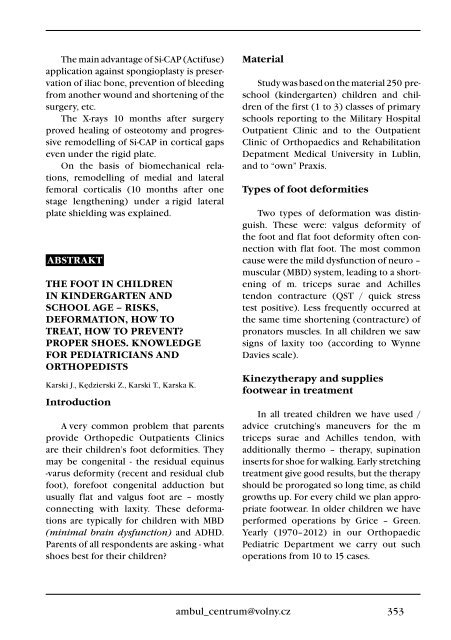3+4+Supplementum/2012 - Společnost pro pojivové tkáně
3+4+Supplementum/2012 - Společnost pro pojivové tkáně
3+4+Supplementum/2012 - Společnost pro pojivové tkáně
- TAGS
- www.pojivo.cz
Create successful ePaper yourself
Turn your PDF publications into a flip-book with our unique Google optimized e-Paper software.
The main advantage of Si-CAP (Actifuse)<br />
application against spongioplasty is preservation<br />
of iliac bone, prevention of bleeding<br />
from another wound and shortening of the<br />
surgery, etc.<br />
The X-rays 10 months after surgery<br />
<strong>pro</strong>ved healing of osteotomy and <strong>pro</strong>gressive<br />
remodelling of Si-CAP in cortical gaps<br />
even under the rigid plate.<br />
On the basis of biomechanical relations,<br />
remodelling of medial and lateral<br />
femoral corticalis (10 months after one<br />
stage lengthening) under a rigid lateral<br />
plate shielding was explained.<br />
aBSTRakT<br />
THe fOOT in CHildRen<br />
in kindeRGaRTen and<br />
SCHOOl aGe – RiSkS,<br />
defORMaTiOn, HOw TO<br />
TReaT, HOw TO PReVenT?<br />
PROPeR SHOeS. knOwledGe<br />
fOR PediaTRiCianS and<br />
ORTHOPediSTS<br />
Karski J., Kędzierski Z., Karski T., Karska K.<br />
introduction<br />
A very common <strong>pro</strong>blem that parents<br />
<strong>pro</strong>vide Orthopedic Outpatients Clinics<br />
are their children’s foot deformities. They<br />
may be congenital - the residual equinus<br />
-varus deformity (recent and residual club<br />
foot), forefoot congenital adduction but<br />
usually flat and valgus foot are – mostly<br />
connecting with laxity. These deformations<br />
are typically for children with MBD<br />
(minimal brain dysfunction) and ADHD.<br />
Parents of all respondents are asking - what<br />
shoes best for their children?<br />
Material<br />
ambul_centrum@volny.cz<br />
Study was based on the material 250 preschool<br />
(kindergarten) children and children<br />
of the first (1 to 3) classes of primary<br />
schools reporting to the Military Hospital<br />
Outpatient Clinic and to the Outpatient<br />
Clinic of Orthopaedics and Rehabilitation<br />
Depatment Medical University in Lublin,<br />
and to “own” Praxis.<br />
Types of foot deformities<br />
Two types of deformation was distinguish.<br />
These were: valgus deformity of<br />
the foot and flat foot deformity often connection<br />
with flat foot. The most common<br />
cause were the mild dysfunction of neuro –<br />
muscular (MBD) system, leading to a shortening<br />
of m. triceps surae and Achilles<br />
tendon contracture (QST / quick stress<br />
test positive). Less frequently occurred at<br />
the same time shortening (contracture) of<br />
<strong>pro</strong>nators muscles. In all children we saw<br />
signs of laxity too (according to Wynne<br />
Davies scale).<br />
kinezytherapy and supplies<br />
footwear in treatment<br />
In all treated children we have used /<br />
advice crutching’s maneuvers for the m<br />
triceps surae and Achilles tendon, with<br />
additionally thermo – therapy, supination<br />
inserts for shoe for walking. Early stretching<br />
treatment give good results, but the therapy<br />
should be <strong>pro</strong>rogated so long time, as child<br />
growths up. For every child we plan ap<strong>pro</strong>priate<br />
footwear. In older children we have<br />
performed operations by Grice – Green.<br />
Yearly (1970–<strong>2012</strong>) in our Orthopaedic<br />
Pediatric Department we carry out such<br />
operations from 10 to 15 cases.<br />
353

















